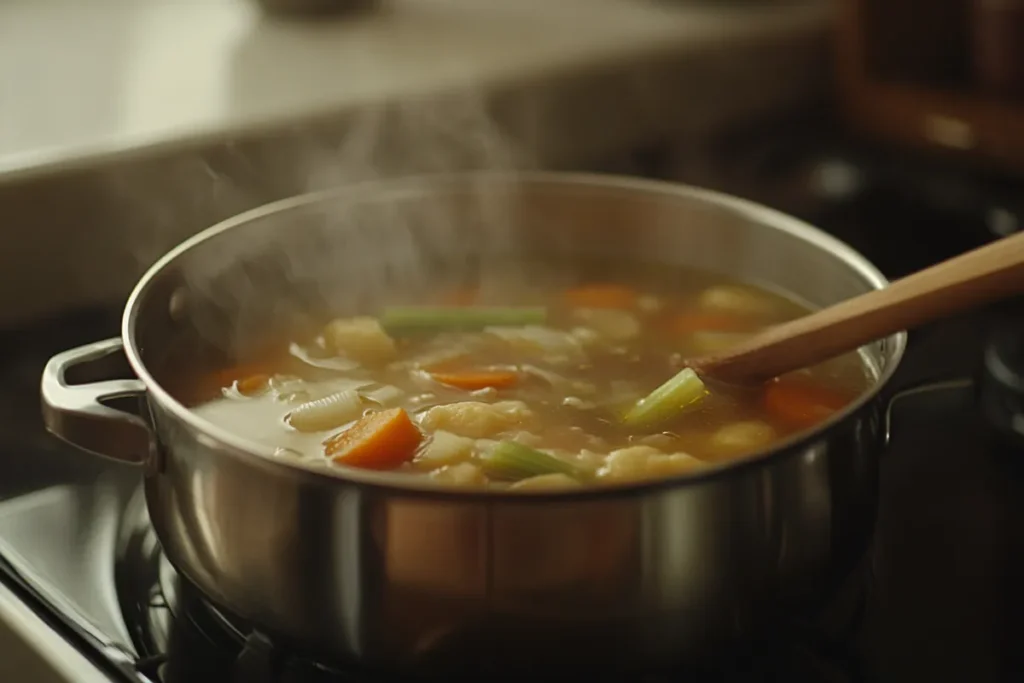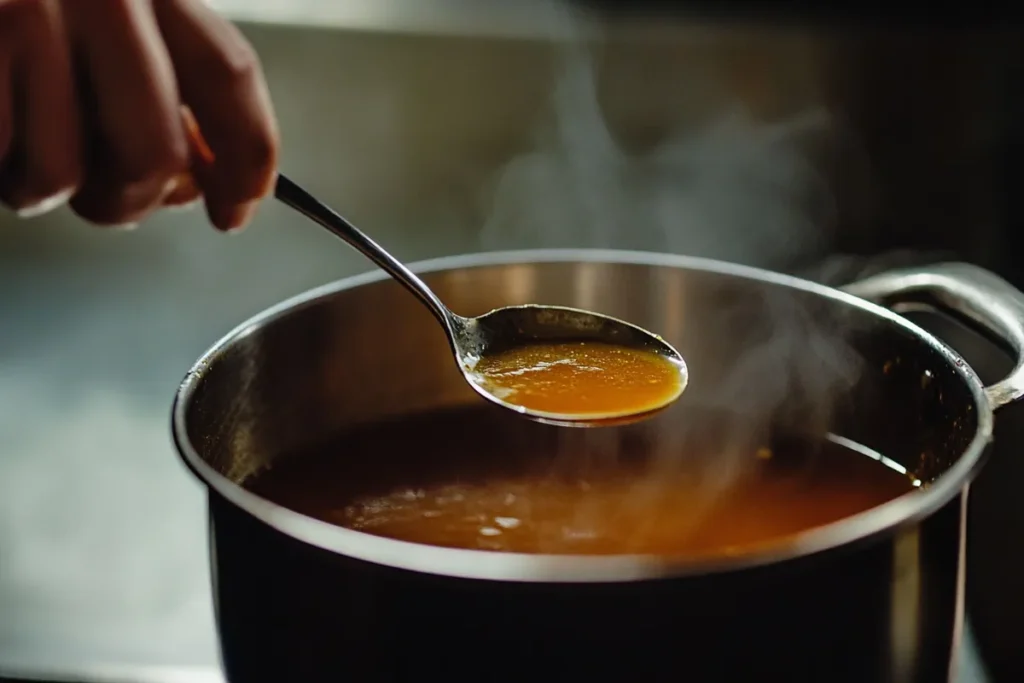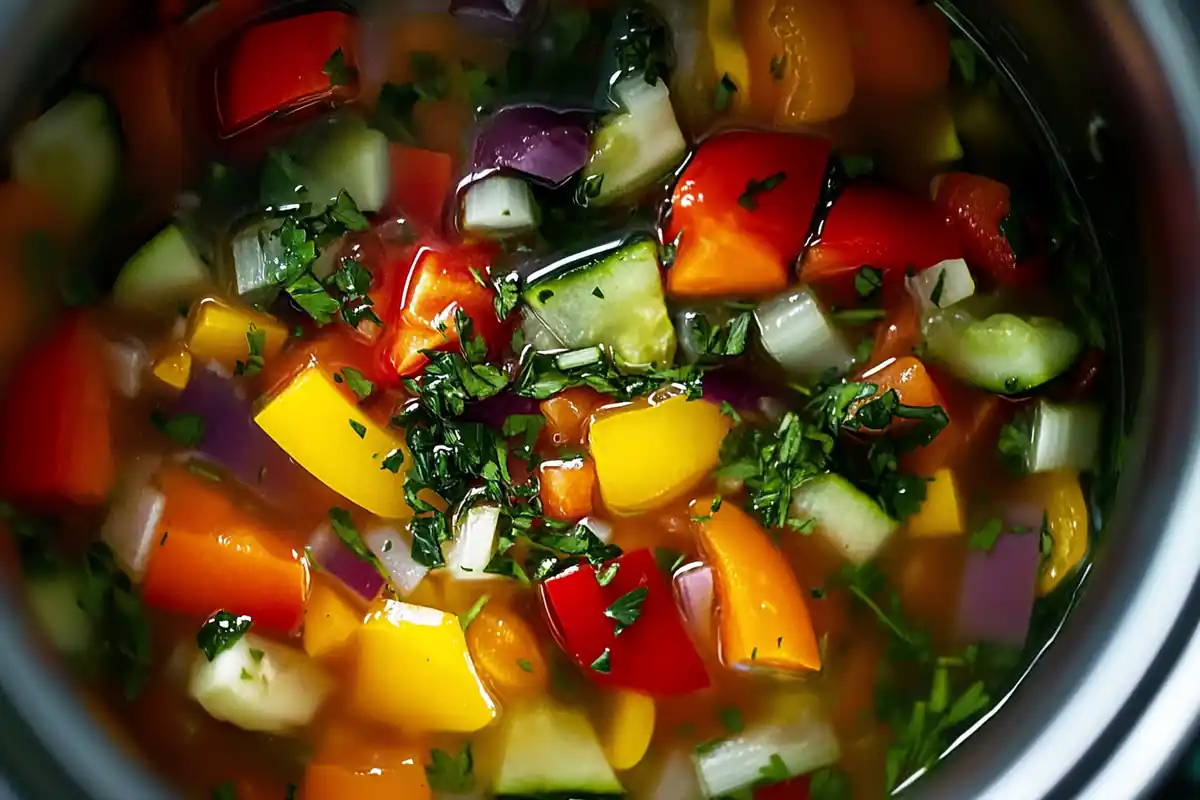Discover the hidden elements that elevate ordinary soup to extraordinary. This guide explores the key to achieving maximum flavor and helps you answer the question, what is the secret ingredient in soup?
The question of what is the secret ingredient in soup is one that many home cooks and professional chefs often contemplate when striving for culinary perfection. The search for that elusive secret to flavorful soup has led to countless recipes and experiments. The truth, however, is that there isn’t just one single, magical element that reveals the secret of delicious soup. Instead, it’s a combination of well-executed techniques and thoughtfully chosen ingredients that collectively create a truly amazing soup. Therefore, understanding the complex interplay of flavors is essential for any soup enthusiast wanting to master the art of soup making. It’s about meticulously layering tastes and textures to achieve a harmonious and deeply satisfying result. This article will delve into the various aspects that contribute to creating great soup, exploring each component that sheds light on what truly makes a soup special.
Table of contents
- Building the Foundation: The Power of Stock and Broth for Soup Flavor
- The Zest of Acidity: Brightening the Taste of Soup
- Adding Depth: Flavorful Additions for Great Soup
- The Importance of Cooking Techniques for Soup Perfection
- The Significance of Quality Ingredients for Optimal Soup Flavor
- Achieving the Perfect Texture for Amazing Soup
- Tasting and Adjusting: The Key to Soup Balance
- Exploring Various Soup Examples
- Creating Your Own Soup Recipes
- Conclusion: Unveiling What is the Secret Ingredient
- Frequently Asked Questions About Soup
Building the Foundation: The Power of Stock and Broth for Soup Flavor

Simmering homemade stock, the key base for any great soup
Moving to the next part, let’s begin with the foundation of any great soup: the stock or broth. The difference between the two is subtle, yet significant. Generally, stock is made with bones, while broth is made primarily with meat. Nevertheless, both contribute a rich base flavor. Therefore, understanding how to make a good stock or broth is essential. First, roasting the bones before simmering enhances their flavor. This process creates a deeper, more complex taste. Next, adding vegetables like carrots, celery, and onions during simmering adds aromatic depth. Also, herbs like bay leaves and thyme lend further flavor.
Furthermore, the simmering process is crucial. A gentle simmer extracts the flavors without making the stock cloudy. Consequently, patience is key. A good stock or broth requires several hours to develop properly. However, it’s worth the wait. The rich, complex flavor of a homemade stock significantly elevates the overall taste of the soup. Therefore, using store-bought stock should only be a fallback if time is limited. If you have time, making your own will make the world of difference.
Additionally, variations in stock exist. For example, chicken stock, beef stock, and vegetable stock each impart different flavors. Depending on the soup you’re making, choosing the appropriate stock base will influence the final result. In the next segment, we will look at the role of aromatics in enhancing the soup.
Aromatics: The Flavor Base for a Delicious Soup
In the subsequent chapter, the next key component is building flavor with aromatics. Basically, aromatics are ingredients like onions, garlic, celery, and carrots. They create a foundational flavor profile. Hence, these are usually the first ingredients you sauté when beginning to cook soup. Accordingly, this process helps release their natural oils and flavors. For instance, when cooking onions, allowing them to sweat before adding other ingredients develops a deeper sweetness. Likewise, adding minced garlic toward the end of the sauté process retains its potent flavor.
Besides, the combination and proportions of aromatics can vary based on the desired flavor profile. For instance, a classic mirepoix (a mixture of onions, carrots, and celery) is common in many soups. Nevertheless, some cultures utilize a soffritto. A soffritto includes onions, carrots, celery, and garlic cooked slowly in olive oil. Additionally, adding herbs like thyme, rosemary, or bay leaves during the sauté stage infuses their flavors into the oil. Consequently, the process significantly enhances the overall flavor. Moreover, these herbs act as a bridge, blending the flavors of the aromatics and stock together.
In the next section, we’ll be exploring how seasoning contributes to the soup’s final profile. It’s just as crucial as the base or aromatics.
The Crucial Role of Seasoning in Soup Recipes
Continuing in the following part, let’s explore the vital role of seasoning. Certainly, salt is more than just a flavor enhancer. Indeed, it accentuates all the other components in the dish. Therefore, adding salt at different stages of cooking helps to layer the flavors. Generally, it is best to season with salt at each stage, not only at the end. Specifically, salting the vegetables as they are sautéing helps release their moisture.
However, salt is not the only seasoning to consider. Pepper adds depth and complexity to a soup’s flavor. Accordingly, freshly ground black pepper offers a much richer taste than pre-ground. Also, other spices like paprika, cumin, or chili powder can add warmth and character. Moreover, the proper use of herbs, both fresh and dried, is essential. For instance, fresh herbs are better added at the end to retain their vibrancy. Dried herbs, however, are best introduced earlier.
Furthermore, understanding the balance of flavors is crucial. Generally, it’s a good idea to taste and season as you go. Thus, you will be able to adjust the levels of salt, pepper, and other seasonings as needed. Because, every ingredient affects the overall flavor. In the next phase, we are going to be discussing the power of acidity to brighten up the soup.
The Zest of Acidity: Brightening the Taste of Soup
Transitioning to the subsequent portion, let’s delve into the critical role of acidity. Many overlook this aspect, yet it’s instrumental in achieving a balanced soup. Generally, acidity adds a brightness that cuts through richness. Also, it keeps the soup from tasting flat. Specifically, adding a splash of vinegar, lemon juice, or even wine before serving can make a significant difference. Therefore, understanding how to use acidity to its full potential is essential.
For example, a squeeze of lemon juice at the end of cooking can bring vibrancy to a creamy tomato soup. Additionally, a dash of red wine vinegar can add a subtle tartness to a hearty beef stew. Besides, cooking with wine during the sautéing process also adds depth. The alcohol cooks off, leaving behind a more complex flavor. Moreover, different types of vinegar impart different flavors. For instance, apple cider vinegar will give a different flavor than white wine vinegar. According to experts, the goal is not to make the soup taste acidic. Instead, it’s about creating balance and depth.
In addition, the amount of acidity needed varies based on the soup. Consequently, taste and adjust until it is balanced to your liking. In the next installment, we are going to be discussing adding depth to a soup with other flavorful additions.
Adding Depth: Flavorful Additions for Great Soup
Proceeding to the next chapter, let’s look at other ingredients that can add depth to soup. Specifically, adding umami-rich components is a great way to create a more satisfying flavor profile. For example, soy sauce, Worcestershire sauce, or even tomato paste can add umami. Furthermore, roasted vegetables can provide a depth of flavor and texture. Roasting them before adding them to the soup increases their caramelized notes.
Another technique is adding rich ingredients. Cream, coconut milk, or butter can give the soup a velvety texture. Also, these richer components will add a luxurious feel and a touch of richness. Additionally, certain ingredients, such as mushrooms, will add an earthy quality. Moreover, smoked ingredients like smoked paprika can lend a smoky depth. However, these need to be used in moderation, since they can overpower other flavors. Basically, understanding how to use these ingredients effectively is crucial.
In the ensuing segment, we will be exploring cooking techniques that enhance flavor.
The Importance of Cooking Techniques for Soup Perfection
Shifting to the next part, it is crucial to explore cooking techniques. These methods can significantly impact the final taste of your soup. Firstly, sautéing or sweating the vegetables before adding liquid is key. This helps unlock the complex flavors hidden within them. Additionally, allowing the vegetables to brown slightly adds another layer of taste.
Secondly, slow simmering or gentle cooking over low heat, is important. This process allows the different components to meld together perfectly. Moreover, the longer a soup simmers, the better the flavors will become. However, do make sure to simmer gently so you do not boil your soup. Furthermore, if the recipe calls for beans or grains, ensure they are properly cooked before incorporating them. Therefore, these should be cooked separately and added only once they’re ready.
Thirdly, some soups benefit from an overnight rest in the fridge. Afterwards, this allows the flavors to deepen and become even more intense. Consequently, the soup tastes even better the day after it is cooked. In the next section, we are going to be exploring the importance of quality ingredients.
The Significance of Quality Ingredients for Optimal Soup Flavor
Advancing to the next topic, let’s focus on the impact of quality ingredients. Certainly, the quality of the ingredients you use directly impacts the overall outcome of the soup. Specifically, using fresh, high-quality produce can make a substantial difference. Furthermore, ingredients like ripe, flavorful tomatoes will provide a superior taste compared to bland, out-of-season ones. Likewise, using high-quality meats and seafood will also be noticeable. Therefore, selecting the best ingredients available is always best.
Additionally, purchasing produce at farmer’s markets is a great way to get fresh, local ingredients. Also, considering organic options can also have an impact on the taste and quality. Moreover, using homemade stocks instead of store-bought varieties can elevate the soup. Hence, the investment in high-quality components pays off in the final product. In the following segment, we will examine how the right texture can make a world of difference.
Achieving the Perfect Texture for Amazing Soup
In the next division, let’s explore how texture impacts a great soup. Generally, the texture of a soup contributes to its overall enjoyment. For example, a velvety smooth texture is highly desired in a cream-based soup. However, other soups like a hearty vegetable soup have a more rustic texture. Accordingly, understanding the texture you’re aiming for is crucial to success.
Moreover, using techniques like pureeing a portion of the soup can improve the final result. Blending some of the ingredients can create a thicker texture. Nevertheless, make sure to avoid over-blending because this can make the soup gluey. Additionally, adding cream, yogurt, or a cornstarch slurry can thicken the soup. Furthermore, adding garnishes like croutons, herbs, or a swirl of cream can provide visual appeal and additional texture. Ultimately, combining flavors and textures creates a satisfying experience.
Moving forward to the next topic, we will be talking about the importance of tasting and adjusting throughout the cooking process.
Tasting and Adjusting: The Key to Soup Balance

Tasting and adjusting seasoning to create the perfect balance in a bowl of soup.
Heading into the subsequent area, let’s discuss the importance of tasting and adjusting while cooking soup. Essentially, this is the most vital skill for making soup. Obviously, tasting at each step lets you ensure that the balance of flavors and seasoning is on point. Thus, you should always taste a dish before serving it. Additionally, you can always adjust. However, you can never take anything away. Therefore, start with a little at a time.
Furthermore, tasting should happen at various stages, not just at the end. For instance, taste after you’ve sautéed your aromatics and adjust any seasoning. Also, taste after you have added the liquids and adjust seasoning as needed. Similarly, taste after you have added any additional ingredients. Consequently, tasting as you go ensures that all flavors work in harmony. Hence, it allows you to adjust before the end of the cooking process. In the ensuing segment, we will delve into various examples of popular soups.
Exploring Various Soup Examples
In the next subsection, let’s look at examples of popular soups and the secret ingredient that makes them great. First, consider the classic tomato soup. Generally, the best tomato soups feature a rich and complex flavor. Also, the acidity of the tomatoes is balanced with a touch of sweetness from sugar. Furthermore, the use of roasted tomatoes adds an additional layer of depth. Consequently, this makes the soup more flavorful.
Secondly, think of a creamy potato soup. A velvety smooth texture is what makes it special. Therefore, carefully blending the soup after cooking, using high-quality dairy, contributes to its success. Additionally, consider how well-seasoned it is. Salt is the most important part. Thirdly, consider chicken noodle soup. This classic comfort food is best when the broth is rich, and the chicken is tender. Specifically, making your own chicken stock is what makes the difference. Ultimately, each soup highlights the importance of various components.
In the succeeding section, we will consider how to use what we’ve learned to create your own recipes.
Creating Your Own Soup Recipes
On to the following discussion, let’s talk about creating your own soup recipes using the principles we have discussed. Initially, start with a base of high-quality stock or broth. Next, choose your aromatics and sauté them until fragrant. Then, add the liquid and any additional ingredients. Subsequently, season as you go and adjust accordingly. Also, be sure to taste at each step to understand the flavors.
Furthermore, think about texture. Depending on your desired outcome, you may want to blend your soup. Additionally, consider the flavors you would like to build. What flavors are you looking to create? Do you want a spicy soup? Something creamy? Something light and fresh? Henceforth, experimenting with different ingredients and techniques will help you develop your own signature soups. Ultimately, making your own recipes comes down to practice and passion.
Conclusion: Unveiling What is the Secret Ingredient
In conclusion, the true secret ingredient in soup is not a single, magical element, but rather a harmonious symphony of techniques, thoughtfully selected components, and a profound understanding of how flavors interact in synergy. It is in understanding what is the secret ingredient in soup that you will achieve soup perfection. Therefore, a full understanding of how these elements interact, and how each step contributes to the overall soup flavor, will empower you to create fantastic soups and fully embrace your culinary journey. By using high-quality ingredients, thoughtfully layering flavors, and paying meticulous attention to every detail, you can make delicious soup that will showcase the culmination of your quest to discover what is the secret ingredient in soup. Hopefully, this guide has enhanced your understanding of the nuances of soup flavor, and has provided you with the essential tools you need to embark on your own culinary journey in discovering what is the secret ingredient in soup. Keep experimenting, tasting, and wholeheartedly embrace the process of creating flavorful soup, and you will undoubtedly come closer to understanding what is the secret ingredient in soup. Remember, the journey to discovering what is the secret ingredient in soup is a rewarding one, and every bowl of soup you make will bring you closer to achieving soup perfection.
Frequently Asked Questions About Soup
Finally, let’s address some frequently asked questions to clear up any remaining doubts. Understanding these concepts will enhance your soup making skills.
Chefs add vinegar to soup to balance the flavors. Indeed, it provides acidity, which cuts through richness and prevents the soup from tasting flat. Furthermore, it brightens the other flavors present in the dish, creating a more well-rounded taste. Also, vinegar will make your ingredients shine by adding that extra touch.
While many components contribute to a good soup, the most important element is high-quality stock or broth. Also, the base sets the tone for the entire soup. Accordingly, a well-made stock is flavorful, balanced, and robust. Therefore, it elevates the overall taste and quality.
Several things give soup the best flavor, including well-developed stock, a base of aromatics, proper seasoning, and balancing acidity. Additionally, patience while cooking is important. Moreover, high-quality ingredients also enhance the final result.
The secrets to flavorful soup are using a great stock, sautéing aromatics, seasoning at each stage, using acidity, high quality ingredients, and proper cooking techniques. Also, tasting and adjusting as you go is vital. Ultimately, it is all about the balance and synergy of the different components.

